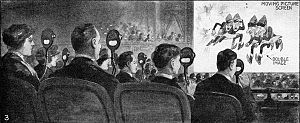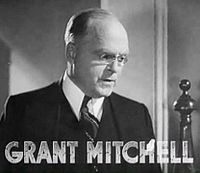The Man from M.A.R.S. (1922 film)
The Man from M.A.R.S. is a 1922 silent U.S. science fiction film. It is notable for using the 3D process called Teleview, similar to todays alternating frame 3D systems. Shown in 3D only at the Selwyn theater in New York City, it was previewed as Mars Calling at a trade and press screening onOctober 1922, premiered as M.A.R.S. onDecember 1922, and ran throughJanuary 1923. A 2D version was distributed as RadioMania in 19231924. The film was directed by Roy William Neil and photographed by George Folsey.
This curious picture is a cross between fantasy and science fiction at least, the 1922 version of science fiction and features Broadway actors Grant Mitchell and Margaret Irving in their motion picture debuts. Arthur Wyman Mitchell is the typical absentminded scientist. He is in love with Mary Langdon Irving, the daughter of his landlady Gertrude Hillman. To help her out, he invents an alarm clock that does not tick this being long before the days of electronic devices. Using the money he has earned writing an article, Wyman tries to put the finishing touches on a radio that will contact Mars. He falls asleep as he is tinkering with it and dreams that he has gotten in touch with the Martians. They give him a lot of valuable informationhe learns a special way to make diamonds from coal, fashion gold from clay, and create steel that weighs less than nothing. What he learns makes him fabulously wealthyuntil, much to his disappointment, he wakes up. But then Mary arrives and tells him that the rights to the tickless alarm clock have been sold for a lot of money, so things work out after all.Teleview was used for showing The Man from M.A.R.S. at the Sewlyn Theatre in New York and then was never seen again. It was invented by Laurens Hammond, best known as the creator of the Hammond organ. Hammond had, in fact, earned money from the invention of a silent clock, which enabled him to establish himself as an inventor. Teleview was very complex for its time as it was a way to project and view stereoscopic images by the alternating frame method. Two projectors ran interlocked, with the left and right images being projected one after the other in repeated rapid succession. Each spectator had a special viewer attached to the arm rest of their chair. A revolving shutter in the viewer ran in synchronization with the projector shutters, blocking each eyes view of the images intended for the other eye, so that the users simply positioned the viewers in front of their eyes and
Source: Wikipedia


